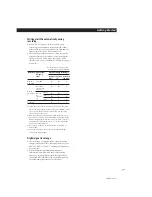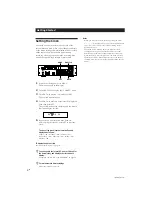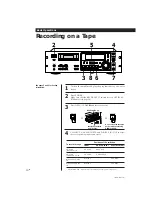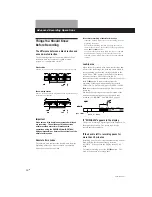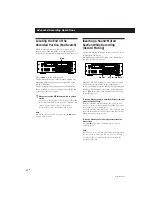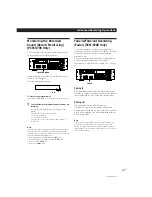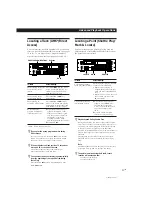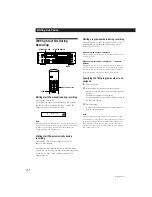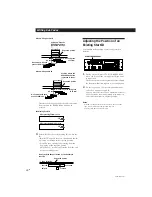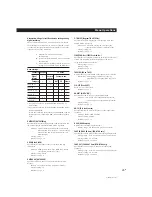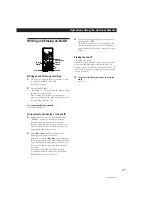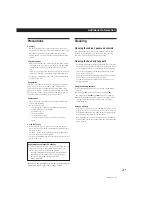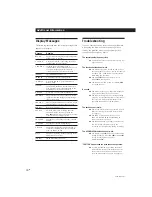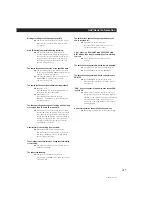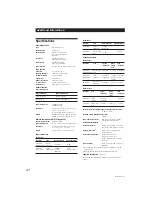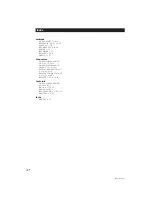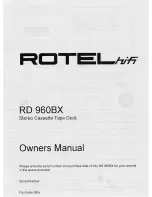
3-859-278-12(1)
Advanced Playback Operations
19
EN
FADER
AUTO
MIN
MAX
OFF
WIRED
WIRELESS
REMOTE
POWER
Ø
ON
ø
OFF
PHONE LEVEL
PHONES
•
•
•
•
•
•
•
•
•
•
•
RENUMBER
REHEARSAL
REHEARSAL
WRITE
WRITE
ERASE
ERASE
REPEAT
SKIP PLAY
LOCATE
MODE
COUNTER RESET
MARGIN RESET
PREVIOUS
AMS
=
OPEN/CLOSE
6
NEXT
+
STOP
p
REW
0
PLAY
(
FF
)
PAUSE
P
REC MUTE
R
REC
r
MENU
DATA
SHUTTLE
CH-1(L)
r
SET
MARK
0
10
ANALOG
DIGITAL
INPUT
REC LEVEL
•
•
•
•
•
•
•
•
•
•
•
OFF
ON
SBM
UNBALANCE
BALANCE
ANALOG INPUT
STANDARD
48k
44.1k
LONG
REC MODE
CH-2(R)
0
10
•
•
•
•
•
•
•
•
•
•
•
START ID
SKIP ID
INPUT
MONITOR
FADER
OFF
ON
KEY PROTECT
Fade-in/Fade-out Playback
(Fader) (PCM-R700 only)
You can use the fader to fade-in the beginning of
playback or fade-out the end of Playback. It’s useful
when you want to record from DAT.
You can specify the fade-in and fade-out durations of
0.5 to 9.5 seconds through the menu settings.
For details, see “FADE IN” and “FADE OUT” on page
25.
Advanced Playback Operations
Writing Sub Codes
,,
,,
,,
,,
,
,
,
,
,
,
,
,
S
t
a
r
t
I
D
S
k
i
p
I
D
T
r
a
c
k
T
r
a
c
k
S
t
a
r
t
I
D
T
r
a
c
k
T
r
a
c
k
E
n
d
I
D
About Sub Codes
In the DAT format, control codes, or sub codes, such as
start IDs, skip IDs, and end ID can be recorded on the
tape with the audio signal. Since sub codes are written
on the tape separately from the audio signal, they have
no effect on the audio signal.
Start IDs
Start IDs indicate the start of a track, and therefore
allow you to locate the position of a track precisely.
The start IDs are 9 seconds in length (18 seconds in
long-play mode) to enable easy detection during fast-
forwarding or rewinding.
Program numbers
Program numbers serve as track numbers. Occupying
the same position as start IDs, a program numbers
allow you to locate specific tracks or play tracks in a
specific order.
Skip IDs
Skip IDs indicate tracks or recorded portions that are to
be skipped while playing. Skip IDs are 1 second in
length (2 seconds in long-play mode).
End ID (when the optional remote is used)
An end ID indicates the end of a recording. An end ID
is 9 seconds in length (18 seconds in long-play mode).
When an end ID is detected during playback, playback
stops and the deck rewinds the tape to its beginning. If
an end ID is detected during fast-forwarding, the tape
stops at that point and deck becomes ready for
recording from that point.
You can write and erase an end ID only with the
optional remote RM-D750. For details, see “Writing
and Erasing an End ID” on page 27.
Notes
• The OPEN/CLOSE
6
, STOP
p
and PAUSE
P
buttons do
not work during the writing or erasing of sub codes.
• Writing and erasing of sub codes and renumbering of
program numbers are impossible if the record-protect hole
on the DAT cassette is open (see page 11).
Fading in
Press FADER while the deck is in play pause mode.
“FADE IN” appears in the display and the time
display counts backward to “0.0s” as the fade-in takes
place.
Fading out
Press FADER during playback.
“FADE OUT” appears in the display and the time
display counts backward to “0.0s” as the fade-out
takes place. After fading out, the deck automatically
enters play pause mode.
Note
Your deck has a digital fader that is capable of fading in or
out in 256 steps. Switching noise, however, may occur
during playback of low-level or single-frequency signals.
If this happens, use a fader on a component, such as a mixer,
connected to the deck.
Содержание PCM-R500 - Dat Recorder
Страница 2: ...Sony Corporation Printed in Japan 3 859 278 12 1 ...
Страница 36: ...35EN 3 859 278 11 1 Index ...
Страница 70: ...35F 3 859 278 11 1 Index ...
Страница 104: ...35D 3 859 278 11 1 Stichwortverzeichnis ...



